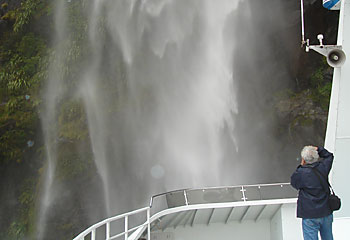Wild sound of nature
STEVE McKenna braves the elements to discover one of New Zealand's most-treasured Fiordland attractions: the dramatic, beautiful and often wet Milford Sound.

MILFORD Sound didn't look like this in the travel brochure.
I had envisaged cruising along the calm, tranquil waters and casting my eyes on the stunning reflections of the soaring cliffs.
So, why I am being blown all over the top deck, peppered with wind and water? Why are the peaks covered in mist? And why are there no reflections in the dark, dank waters?
It's so gloomy that the Loch Ness monster would thrive in this place.
I suppose next we'll be pulverised by an earthquake.
What? They have them here?
"On average, we get one quake a day," our Kiwi captain says. "But most are so small we don't even feel them."
Oh, great, I thought, as I made my way back indoors to dry off, while listening in on the skipper's commentary for more unexpected revelations.
"You probably woke up this morning expecting to see a sound at Milford Sound," he added, dramatically. "Well, this is actually a fjord."
I was beginning to wonder what else were they going to feed us when the man at the helm explained the differences: the latter, having been etched by glacial movements millions of years ago, is far more dramatic and picturesque.
As the boat continued its 15km passage downstream towards the Tasman Sea, we were directed towards some of Milford's most spectacular sights.
At 1692m high, Mitre Peak is arguably the piece de resistance. Looming large over the waters, it's a joy to behold – despite the fact that it's a hazy, drizzly day and visibility is patchy at best.
But they often get days like this on Milford Sound. Well, they would.
Moisture is dragged across the Tasman from Australia and unceremoniously dumped here at such a rate that the average annual rainfall often exceeds 6m.
The tour companies must have taken the photographs for the glossy brochure on one of the few dry days. Although I feel slightly tricked, I shouldn't moan – because, while this is hardly the most comfortable cruise I've had in my life, it's certainly one of the most beautiful.
The extra rain means Milford's other highlights – its cascading waterfalls – are absolutely gushing.
Bowen and Stirling Falls, in particular, are surging today and the captain even navigates the front of the boat underneath them so we can gauge their sheer power.
I feel fairly insignificant when feeling the brunt of the water hammering against the vessel, and rather pleased that I'm standing as far back as possible, while the brave souls at the other end are absolutely sodden.
The crushing force of the falls is simply awesome, and it makes for some marvellous photographs.
You can say that for the Sound as a whole. But, like so many areas of natural beauty – this is part of the World Heritage-listed Fiordland National Park – pictures just do not do this place justice.
There is an eerie, almost creepy feel about it, as if you have stepped back in time. In fact, if it wasn't for the boats and catamarans that clog up the Sound you'd never be able to tell what century you were in.
Or world, come to think of it. Like many of New Zealand's natural beauties, Milford was used for Lord Of The Rings.
Nor can you disagree with revered author Rudyard Kipling who called it the eighth wonder of the world. The Sound's majestic, plunging cliffs, dotted with lush rainforest and a touch of snow, are easy on the eye while the marine creatures – dolphins, seals and the rare hoiho yellow-eyed penguin – bring the place to life.
We even stop off at an underwater observatory where we are given a further glimpse of what lies beneath the deep, tannin-stained waters (the lowest parts of the Sound are around 400m deep).
It's mildly interesting – especially the starfish and black coral – but after a half-hour I'm glad to get back on the boat for its return to the harbour.
The five-hour journey was one of the most memorable road trips I'd ever been on, particularly the final 119km leg from Te Anau to Milford.
Dramatic forests, plunging valleys and craggy, snow-tinted mountains, combined with sheep-filled flatlands and pristine reflective lakes, ensured I was gasping – and snapping away on my camera – almost non-stop.
The Sunday Telegraph

